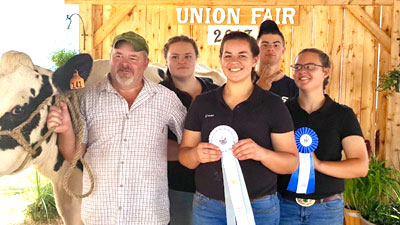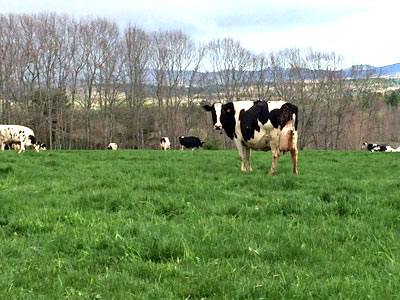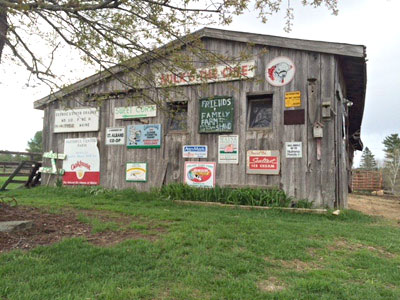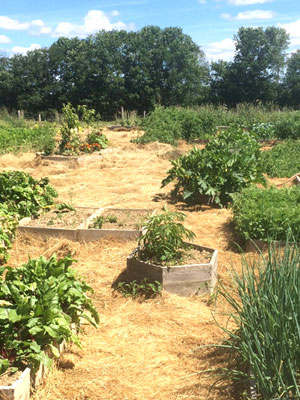 |
| Jodie Martin (center) is busy taking care of young Asa (left) and Lena but still has time to do the books for Faithful Venture Farm, run a CSA, start an orchard and volunteer for Cooperative Extension. |
 |
| Glendon Mehuren (left) with his older children after winning Grand Champion Dairy Cow at the Union Fair 2017. Elida and Silas are in the back, and Emma and Sadee in the front, left to right. |
 |
| Faithful Venture’s Holsteins graze on picturesque pasture. |
 |
| One of the barns at Faithful Venture Farm. |
 |
| Martin’s vegetable garden is well nourished with composted cow manure. |
By Sonja Heyck-Merlin
Photos by Jodie Martin
“My grandfather can remember when there were 28 farms in Searsmont shipping milk,” says Glendon Mehuren, a Waldo County organic dairy farmer. “And in the 20 years we’ve been dairying, six farms between here and Morrill village have closed up.
“Now, we’re the only dairy farm left in the towns of Searsmont, Montville, Liberty, Morrill, Belmont, Hope, Lincolnville – and that list goes on and on,” Mehuren says.
He farms with his partner, Jodie Martin (raised in Montville), and their two young children, Asa (4) and Lena (3). With the demands of two young children having affected Martin’s ability to participate in day-to-day cow chores, she says, “I primarily serve as the farm accountant and PR person.” Two years ago, she also began offering CSA (community supported agriculture) work shares through her garden, and she is creating a pick-your-own fruit orchard.
A Long History of Dairying
Mehuren can trace his ancestry in the area back to the 1840s and says that “the neighborhood is filled with relations of all kinds.” He adds, “There is lots of family around to help with things and who have an understanding of the cow business. If all that family didn’t exist, it probably would have been better for someone to use this farm as a hobby farm or for beef.” He’s alluding to the hilly, steep terrain of the farm, situated on a southwest slope between the plateau of Knox Ridge and the mountainous Camden Hills.
“I don’t know if we have one field that doesn’t have large rocks sticking out,” says Mehuren. Much of the land they own is heavily wooded, requiring them to rent the majority of their hay ground as well as some additional pasture. The rented land is scattered across Searsmont, Morrill and Montville. Between rented and owned ground, they farm about 250 acres.
“The piece we own is backland from my grandparents’ original farm,” Mehuren says. “They retired from milking in 1974. My father stayed on for a few years, but the farm was eventually sold, and my father went to work in the woods.”
His grandparents retained the backland and built a retirement home, which is the house Martin and Mehuren live in now. His grandparents raised oxen, using them in the woods and pulling competitively at agricultural fairs. They also raised replacement heifers and beef.
After attending a two-year agricultural program at Vermont Technical Institute, Mehuren returned to Maine and worked as a state dairy inspector for 11 years. Simultaneously, he began developing dairy infrastructure and building a dairy herd by purchasing newborn heifer calves from an East Newport farm.
“There was a gap in milking from 1974 to 1998,” Mehuren says, “but other than that gap, my family history of milking cows goes back multiple generations.”
From 1998 to 2008, the milk was shipped to Oakhurst. The farm transitioned to organic and shipped its first load of organic milk in 2008.
Building Infrastructure
When Mehuren started milking, the cows were housed in a bedded pack barn and milked in an eight-cow flat parlor with a pipeline. In the last 10 years, he has added a hay storage barn and a sawdust-bedded hoop barn for heifers. In 2015, he completed a sand-bedded freestall barn with space for 56 head – for $60,000. Most estimates put the cost of a barn of this size at roughly $2,000 per stall. The new barn has three rows of stalls with an enclosed feed alley and is connected to the milking parlor by a breezeway.
“We used lots of recycled materials,” Mehuren explains about the new barn. “The trusses came from a covered manure pit in St. Albans. All of the stalls were reused. The neck rail is all used boiler pipe from a chicken house, and a lot of the lumber was recycled.” Mehuren acted as the contractor, hiring carpentry help where needed, and says the barn was built with “begged, borrowed and stolen labor.”
They did not build a new parlor to go with the new barn, and Mehuren says getting away from the old parlor is one goal. Currently, it takes them three to four hours each time they milk 40 cows.
“I would like a more efficient parlor, which allows us to move cows through more quickly, and something that is more conducive to cleaning with a hose,” he says.
Feed and Fertility
In a typical freestall barn, cows are fed a TMR (total mixed ration), which is generally dispensed out of a machine into a feed alley. At this point, the farm lacks the equipment necessary to make and dispense a TMR, so in winter they use ring feeders to feed round bales outside. On the most frigid of days, the 1,400-pound bales of balage must be unrolled in the feed alley and dispersed with pitchforks. Free-choice dry hay is also available for the herd throughout the year.
The farm produces 1,200 to 1,400 round bales per year. The primary haying equipment is a 3160 Kuhn disc mower pulled by a Massey Ferguson 1105, a New Holland 163 Digi-drive tedder pulled by a Massey Ferguson 245, a Vicon rotary rake pulled by a 245 Massey Ferguson, and a New Holland 4060 baler pulled by a Massey Ferguson 1085.
About 60 percent of the hay is in the form of balage, with the remainder in dry hay. Balage is individually wrapped and stored outside. The hillside farm is idyllically located and is advantageous in the amount of airflow it provides to the cows, but when it comes to producing quality stored feed, Faithful Venture is at a disadvantage.
Since the hay fields tend to be small and far apart, “It’s not unusual for us to lose a piece of equipment,” says Mehuren. “We spend a lot of time moving equipment between fields. It slows us down. We can’t move equipment fast enough and hay as efficiently as if we had bigger pieces of ground.”
Lack of fertility is also a barrier to putting up the quality feed needed to maintain the energy levels of lactating dairy cows.
“When I started farming, all of the ground on the home farm as well as every piece of rented ground was backwards in fertility,” says Mehuren. “As people sold their cows, they continued to produce hay without generating any fertility.”
He imports chicken manure (spread at a rate of 5 tons per acre) to increase the fertility of their larger, more productive fields.
“If we could be successful with increasing yields on our better ground,” Mehuren says, “we could back off from our more marginal ground.”
A Strong Herd
The herd consists of 45 milking cows and 45 heifers, all registered Holsteins. Average production is 60 pounds per day. Somatic cell count averages 150,000 to 170,000. Butterfat averages 3.6 percent and protein, 3.1 percent. The average weight of a milk cow is 2,000 pounds.
“The herd is characterized by strong and posty rear legs with good feet and well attached udders,” Mehuren says. “They take an awful lot of feed, both in growing young cows and when they are lactating.
“They are not the ideal grazing cows because of their high energy demands, but we like them and so that is what we do,” he continues.
To grow and maintain these large-framed animals, they supplement the herd with 16 to 24 pounds of organic grain per day, fed in the parlor during milking. The grain ration stays consistent throughout the year.
“Without corn silage, we have to make up the energy somewhere,” Mehuren says. “The grain is important for making up what we can’t produce ourselves.”
During the grazing season, which generally begins by mid-May, the milk cows graze rotationally on 60 acres of pasture that is contiguous to the farm. They are moved every 12 to 24 hours. Younger heifers and dry cows are pastured on rented ground. Dry matter intake from pasture during the primary grazing season is about 50 to 60 percent.
The past two summers have been oppressively dry at the farm, requiring Mehuren to supplement the cows with balage during the grazing season, and in turn forcing him to purchase additional forage to get through the winter. He expresses frustration that Waldo County did not qualify for drought relief in 2016, even though neighboring counties did.
“Other farmers were paid for pasture losses, but we were not. It would have been nice to be able to recoup some of the financial loss created by the drought,” he says. He filed an appeal but it was denied. “Unfortunately, I can’t pick up the whole [farm] and shove it across the county line.”
In a year with adequate moisture, Mehuren clips the pastures at least twice with a New Holland 10-foot disc mower.
“I don’t know if we have the ideal stand of pasture grasses,” he says. “The cows don’t seem to like the fescues and finer grasses. I also get refusal with orchard grass. If any of those species get over-mature or start to show a head, [the cows] tend to walk away.”
The Cost of Producing Less Milk
The droughts of 2016 and 2017 have had a major impact on the economy of Faithful Venture, as have severe pay price cuts. Horizon Organic, which buys their milk, has reduced its pay price by $6 per hundredweight since September of 2017.
“On top of that,” Mehuren says, “they have also asked for a 10 percent reduction in milk production.”
He continues, “Cutting back on production is not as easily accomplished as one might think. I could cut back on how much grain I feed, but that means the cows have less energy and carry less weight into their dry period. This can cause metabolic and conception issues. In this herd, there is a cost that comes with producing less milk.”
A farmer whom Glendon knows has calculated that the combination of a 10 percent reduction in production and the cut in pay price has reduced Horizon’s pay price by approximately 25 percent. Faithful Venture is currently grossing about $30 per hundredweight. Lately the farmers have had to make some difficult decisions about which animals to keep in the herd in order to reduce production.
“I just reduced the herd size by eight cows in the last two weeks to make room for some heifers,” says Mehuren. Six were sold as organic dairy cattle and the other two went to beef.
“I would have preferred to keep them. Even if Horizon decides to allow an increase in production, I can’t see that it would be enough for me to integrate seven or eight first-calf heifers.”
The reduction in milk prices has cut into the farm’s margin, but Mehuren says they are doing all right as far as paying bills. At the current pay price, however, Mehuren believes that there “is not much of a buffer for unexpected costs such as an integral piece of equipment breaking or a costly repair outside of the normal.
“I think ultimately, the ability to survive depends on how efficiently you can operate, how little waste you can produce, and your ability to go without things you want and maybe even need.”
Good Family Time
Mehuren has four children from a previous marriage (Elida, Sadee, Emma and Silas), and all four have been showing these registered Holsteins since a young age. The four older children are also well versed and skilled in Faithful Venture’s daily chore routine. Mehuren’s father still helps with daily chores, and they employ a neighbor who is a senior in high school.
“I grew up showing cows, steer and oxen,” Mehuren says. “Showing cows is our summertime recreation and has always been good family time for us.”
They generally take in six fairs, including the Common Ground Country Fair. In fact, Mehuren has been bringing cattle to Common Ground for 30 years! He started with oxen, but Faithful Venture’s role has evolved to bringing about eight cows to Common Ground.
Martin says, “We think it is important for the public to see the organic dairy industry represented at Common Ground and see that it plays a large part in Maine’s agricultural economy.”
Beyond their involvement with showing cattle, each member of the family is clearly dedicated to preserving the agricultural traditions of Maine. Elida (21) is a medical assistant but recently bought two organic Holstein heifers as show cattle. Sadee (20) is enrolled in the animal science program at the University of Maine and has traveled extensively across the United States representing the Maine 4-H community. Emma (18), a senior in high school, plans to study animal science as well. She is the current Maine Dairy Princess, an honor she took over from Elida, who was the Maine Dairy Princess in 2015-16. Silas (16), currently a sophomore in high school, is enrolled in a diesel tech program and has a reputation among his peers for his prowess with operating heavy equipment.
Martin belongs to the Waldo County 4-H Leaders’ Association, serving as treasurer and coordinating the yearly fundraiser and benefit auction for the Waldo County 4-H program. She is also a committee member of the Waldo County Extension Association and of the Maine Organic Milk Producers. The entire family belongs to the Union Harvest Grange.
Despite the economic challenges, Martin and Mehuren remain optimistic and committed to their farm lifestyle.
“There’s a lot more to it than money,” Martin says. The intrinsic benefits of the dairy farm are numerous: an infinite supply of composted manure for Martin’s large vegetable garden, which supplies her CSA, and for the growing orchard; sides of beef to sell to friends and neighbors; and the ability to work from home with their family and children alongside.
“Whether or not any of the older children will come home and continue on with this herd is yet to be seen,” says Mehuren. “It would be my hope that eventually I would have more time to enjoy this piece of Maine I call home.”
About the author: Sonja Heyck-Merlin and her partner, Steve Morrison, raise cows, gardens, grass and kids on Clovercrest Farm in Charleston, Maine. Clovercrest Farm, a second-generation dairy farm, milks 90 Jerseys and has been MOFGA-certified organic since 1995.
